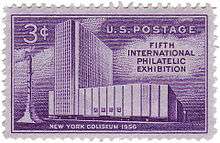New York Coliseum

The New York Coliseum was a convention center that stood on Columbus Circle in New York City from 1956 to 2000. It was designed by architects Leon and Lionel Levy[1] in a modified international style, and included both a low building with exhibition space and a 26-story office block.
History
The Coliseum was built from 1954 to 1956 by the Triborough Bridge and Tunnel Authority under city planner Robert Moses, who, in rescuing a project that had long languished, condemned the area from West 58th to West 60th Streets on the west side of Columbus Circle.[1] During construction in 1955, an accident occurred in which around 10,000 square feet (930 m2) of exhibition space collapsed, injuring 50 workers and killing one.
The Coliseum, which replaced the Circle Building[2] and smaller tenement and retail buildings,[1] opened on April 28, 1956, with three exhibitions: the New York International Auto Show, the National Photographic Show, and the Fifth International Philatelic Exhibition.[1] A U.S. postage stamp commemorates the show and the building. Through 1986, the Coliseum hosted 1,246 events.[1]
The 323,000-square-foot (30,000 m2) Coliseum contained four exhibition floors, including a 150-foot (46 m)-square, three-story well for exhibiting large items, such as sailboats and airplanes.[1]
Closing and demolition
As the Jacob K. Javits Convention Center, which effectively supplanted the Coliseum as the major exhibit space in New York City, was under construction, it appeared that the days of the Coliseum were numbered, and the Metropolitan Transportation Authority (MTA), by now the parent of the Triborough Bridge and Tunnel Authority, placed the property for sale. A deal was struck in 1987 to sell the Coliseum and its office building to Boston Properties for $477.5 million, which would have seen the complex demolished by 1988. A plunging real-estate market and opposition to Boston Properties' proposals ultimately led Boston Properties to walk away from the project in 1994.[3] In the interim, the MTA, seeking to make some use of the site once the future of the Boston Properties site became unclear, reopened the Coliseum on an interim basis in 1992 for smaller events, primarily a thrice-a-year antiques show, until finally closing for good in January 1998.[4]
In the mid-1990s, another attempt to sell the Coliseum was made, this time, to an investment firm headed by Israel Englander, who proposed to build luxury apartments and a ballroom on the site. However, with the real estate market rebounding, a critical $50M tax break was withdrawn by then-mayor Rudolph Giuliani (seeing a tax break for a property that would not draw permanent jobs to the site as unnecessary), at which point Englander's Millennium Partners walked away from the project.[3] In 1998, a deal was struck to sell the property to a joint venture of Time Warner and The Related Companies. Although this $345 million bid was $45 million less than the high bid for the land offered by Donald Trump, the Time Warner/Related proposal was seen as a lock for approval by city authorities. Following asbestos abatement, demolition of the Coliseum and its attached office building began in the winter of 2000 and was complete by that summer.[4] The Time-Warner-Related joint project, now called the Time Warner Center, now stands on the site.
References
- 1 2 3 4 5 6 Gray, Christopher (1987-04-26). "The Coliseum; The 'Hybrid Pseudo-Modern' on Columbus Circle". New York Times. Retrieved 2009-09-05.
- ↑ NYC-Architecture.com: The New York Coliseum
- 1 2 Charles Bagri (July 28, 1998). "A DEAL IS STRUCK FOR COLISEUM SITE". New York Times. Retrieved February 8, 2016.
- 1 2 David Dunlap (February 20, 2000). "Built, but Not Destined, to Last; A Robert Moses Legacy, Coliseum Is Coming Down". New York Times. Retrieved February 8, 2016.
Coordinates: 40°46′07″N 73°58′59″W / 40.768735°N 73.982938°W
